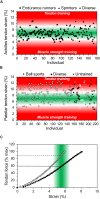Individualized Muscle-Tendon Assessment and Training
- PMID: 32670094
- PMCID: PMC7332733
- DOI: 10.3389/fphys.2020.00723
Individualized Muscle-Tendon Assessment and Training
Abstract
The interaction of muscle and tendon is of major importance for movement performance and a balanced development of muscle strength and tendon stiffness could protect athletes from overuse injury. However, muscle and tendon do not necessarily adapt in a uniform manner during a training process. The development of a diagnostic routine to assess both the strength capacity of muscle and the mechanical properties of tendons would enable the detection of muscle-tendon imbalances, indicate if the training should target muscle strength or tendon stiffness development and allow for the precise prescription of training loads to optimize tendon adaptation. This perspective article discusses a framework of individualized muscle-tendon assessment and training and outlines a methodological approach for the patellar tendon.
Keywords: diagnostic; individualization; mechanical properties; performance; ultrasound.
Copyright © 2020 Arampatzis, Mersmann and Bohm.
Figures


References
LinkOut - more resources
Full Text Sources

